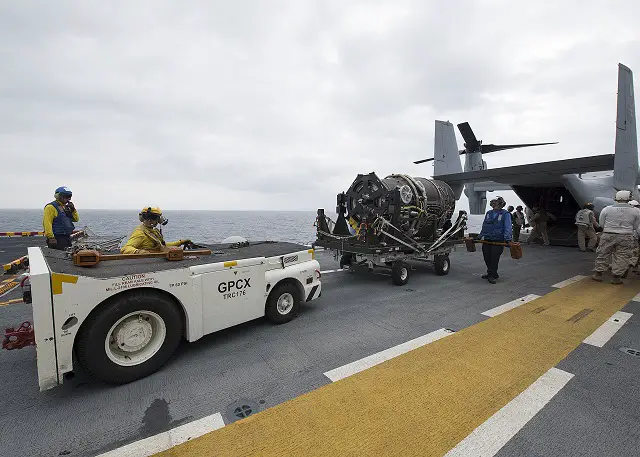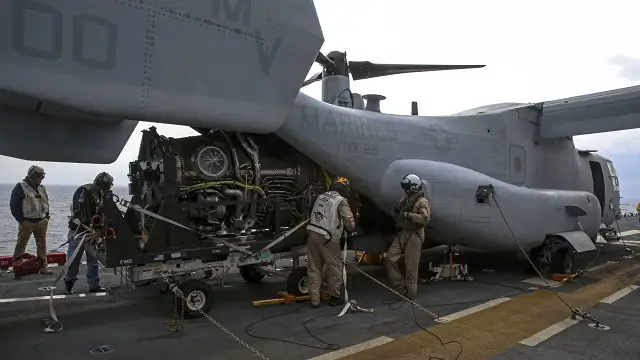Breaking news
MV-22B Osprey Used To Support USMC F-35B Aircraft On Board USS Wasp At Sea.
| 2015
 Sailors
and Marines remove a generator for the F-35B Lightning II aircraft from
an MV-22 Osprey assault support aircraft aboard the amphibious assault
ship USS Wasp (LHD 1). Wasp is underway conducting the first phase of
operational testing for the F-35B Lightning II aircraft. (U.S. Navy photo
by Mass Communication Specialist 1st Class Elizabeth Vlahos/Released) Sailors
and Marines remove a generator for the F-35B Lightning II aircraft from
an MV-22 Osprey assault support aircraft aboard the amphibious assault
ship USS Wasp (LHD 1). Wasp is underway conducting the first phase of
operational testing for the F-35B Lightning II aircraft. (U.S. Navy photo
by Mass Communication Specialist 1st Class Elizabeth Vlahos/Released) |
|||
"The
power module is the core of the F-35B engine," said Michael Chotkowski,
who is in charge of F-35B deployment integration with Pratt & Whitney.
"The engine is broken down into five different modules: fan, augmenter,
nozzle, gearbox and the power, which is the number one module." Up until a few months ago, there was no way to transport replacement power modules to a ship, or damaged power modules from the ship to a repair facility. That was, until a system was put in place using an MV-22B Osprey, a shipping stand constructed with internal suspension, known as a "buck," and an overhead bridge crane aboard the ship to insert the power module into the plane. "Pratt & Whitney had to design and build a shipping buck that could constrain and protect the power module when it is in the back of an MV-22B," said Jeff Ward, who is in charge of F-35B deployment integration with Headquarters Marine Corps. "The buck, which is the critical piece here, did not exist six months ago. It was created to hold and protect the power module while it is being transported." The buck was designed as a portable casing to roll the power module onto and off the Osprey. It also serves to protect the power module in the back of an MV-22B Osprey as it flies across the open sea, where it is subjected to the standard movement and vibrations that are inherent in amphibious flight operations due to high winds and rough water. "The buck has four solid steel posts and two tools on the front and on the back mount of the engine cases. This provides structural integrity," said Chotkowski. "It also has vibratory isolators built into it that are tuned to dampen out the frequencies that come from the MV-22B, and could do damage to the bearings in the power module." Part one of the operation consisted of loading the power module onto a buck at Naval Air Station Patuxent River, Maryland. Next, an MV-22B Osprey from New River, North Carolina flew into Patuxent River to pick up the module and buck. Then the Osprey flew more than 60 miles out to the ship, touching down on the deck of USS Wasp, as it rolled with the waves. The team then wheeled the buck out of the Osprey and onto the deck of the ship, with just several inches of clearance on either side. "The process of unloading the module from the MV-22B is very difficult, because even though the module outside of its container is smaller, it is still very large for the MV-22B," said David Myersm, who is a part of the cargo and special operations team with U.S. Naval Air Systems Command. "It took 16 straps to tie it down in the aircraft. Cargo in the MV-22B needs to be restrained in a specific manor, and it takes a lot of straps to hold down 9,000 pounds." The next stage dealt with lowering the power module down to the ship's maintenance bay, and proving the ability to safely transfer the module from the shipping buck into an existing container. This was accomplished by personnel from Marine Operational Test and Evaluation Squadron 22. "We had to show that we could use the Navy's overhead bridge crane [built into the ceiling of the hangar bay] to transfer the power module from the shipping buck to an existing container, where it can be stored for long term if necessary," said Chotkowski. The demonstration proved to be successful, allowing for data to be drawn and lessons to be learned for future F-35B deployments aboard amphibious vessels. "From this evolution, we know that we can now put a power module into an MV-22B and bring it out to an amphibious vessel," said Ward. "We can now resupply the Marine Corps, Navy and Air Force in any environment by using the MV-22B. This is an important milestone for the program." Ed. Note: As we reported recently, the U.S. Navy is procuring 48 V-22 Osprey to answer its future Carrier Onboard Delivery requirements. |
|||



























